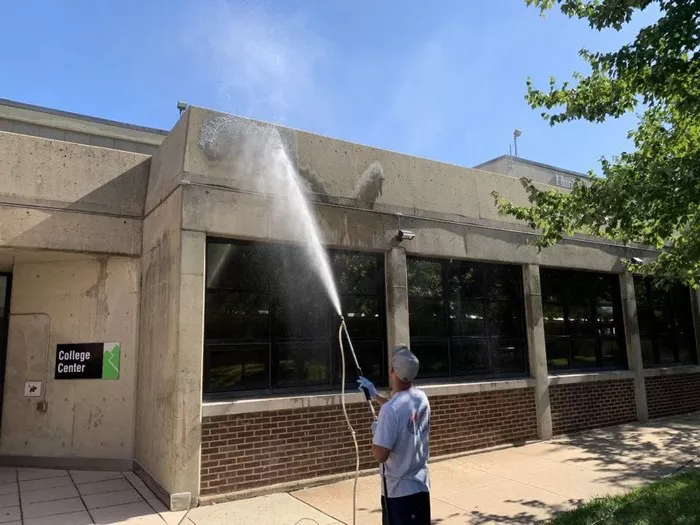Brick pavers are a popular choice for patios, driveways, and walkways due to their durability and aesthetic appeal. However, over time, they can accumulate dirt, moss, algae, and stains, diminishing their visual appeal. Pressure washing is an effective way to restore the beauty of brick pavers, but it must be done carefully to avoid damaging the surface.
This article provides a step-by-step guide on how to pressure wash brick pavers effectively and safely.
The Importance of Cleaning Brick Pavers
Regular maintenance of brick pavers ensures their longevity and keeps them looking attractive. Dirt and debris can settle into the crevices of pavers, leading to discoloration and erosion. Pressure washing removes grime and restores the original color, enhancing the overall appearance of your outdoor space.
Why Choose Pressure Washing?
Pressure washing is a quick and efficient method to clean brick pavers. The high-pressure water effectively removes embedded dirt and tough stains without requiring harsh chemicals. It is also environmentally friendly when done with just water.
Potential Risks
While pressure washing is effective, improper use can damage pavers. Using excessive pressure may erode the surface, dislodge the sand between the bricks, or cause cracks. It’s essential to use the right techniques and tools to prevent these issues.
Preparing to Pressure Wash Brick Pavers
Proper preparation is key to successful pressure washing. It ensures the process is efficient and minimizes the risk of damage.
Gather the Right Equipment
For pressure washing brick pavers, you’ll need a pressure washer with adjustable settings, a spray wand, and appropriate nozzles. Use a cleaner designed for pavers if additional cleaning agents are necessary. Make sure to wear protective gear, including gloves and goggles.
Inspect the Brick Pavers
Before starting, inspect the pavers for damage. Look for loose or cracked bricks and repair them to prevent further deterioration during pressure washing. Check the joints between the pavers to ensure the sand is intact.
Clear the Area
Remove any furniture, plants, or decorations from the area. Sweep the surface to clear away loose debris like leaves and dirt. This step prevents debris from being blown around during washing and makes the cleaning more effective.
Steps to Pressure Wash Brick Pavers
Once you’ve prepared the area, follow these steps to pressure wash brick pavers efficiently and safely.
Step 1: Choose the Right Nozzle
The nozzle determines the pressure and spray pattern of the water. For brick pavers, use a 25-degree nozzle, which provides a wide spray suitable for cleaning without causing damage. Avoid narrow nozzles, as they produce high pressure that can harm the pavers.
Step 2: Adjust the Pressure Setting
Set the pressure washer to a low or medium setting. Generally, a pressure of 1,000 to 1,200 PSI is sufficient for cleaning brick pavers. Start at the lower end of the range and increase slightly if needed.
Step 3: Pre-Wet the Surface
Dampen the pavers with water before applying the pressure washer. This step helps loosen dirt and reduces the risk of surface damage by softening the buildup.
Step 4: Begin Washing
Hold the spray wand at a slight angle, about 12 inches from the surface. Work in small sections, moving the wand in a sweeping motion. Avoid focusing the spray on one spot for too long to prevent erosion.
Step 5: Address Stubborn Stains
For tough stains, apply a paver cleaning solution. Let it sit for the recommended time, then use the pressure washer to rinse it off. Stains caused by oil or grease may require additional scrubbing with a stiff brush before washing.
Post-Washing Maintenance
After pressure washing, it’s essential to restore and protect the pavers to maintain their condition.
Reapply Joint Sand
The pressure washing process may dislodge the sand between the pavers. Once the surface is dry, apply polymeric sand to the joints and sweep it in with a broom. The sand stabilizes the pavers and prevents weed growth.
Seal the Pavers
Sealing brick pavers after washing helps protect them from stains, weathering, and fading. Choose a sealant designed for brick surfaces and follow the application instructions. Sealing also enhances the color and provides a polished finish.
Tips for Maintaining Brick Pavers
Regular upkeep reduces the need for frequent pressure washing and extends the life of your brick pavers.
Keep the Surface Clean
Sweep the pavers regularly to prevent dirt and debris buildup. Address spills promptly to avoid stains setting in.
Remove Weeds and Moss
Weeds and moss can grow in the joints of pavers, causing structural issues. Remove them manually or use a gentle herbicide to keep them under control.
Avoid Overwashing
Pressure washing is effective, but overuse can wear down the surface of brick pavers. Limit washing to once or twice a year, depending on the level of dirt accumulation.
Common Mistakes to Avoid
Pressure washing brick pavers requires precision. Avoid these common errors to ensure the process is safe and effective.
Using Excessive Pressure
High pressure can erode the surface of the pavers and dislodge the joint sand. Always use a moderate pressure setting and appropriate nozzle.
Skipping Repairs
Cleaning damaged pavers can worsen cracks or displace loose bricks. Address repairs before pressure washing.
Ignoring Post-Washing Care
Failing to replace joint sand or seal the surface leaves pavers vulnerable to erosion and stains. Proper aftercare is essential for long-lasting results.
Conclusion
Pressure washing is a powerful and efficient way to restore the beauty of brick pavers. By following the right techniques and taking precautions, you can achieve excellent results without damaging the surface. Regular maintenance and occasional pressure washing ensure your brick pavers remain attractive and durable for years to come.
Related topics:

